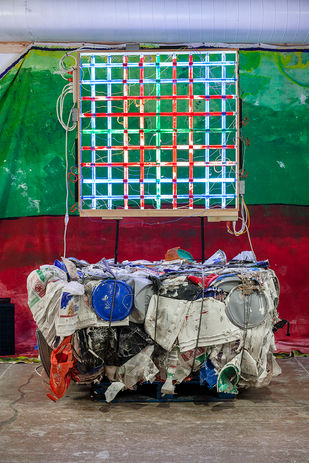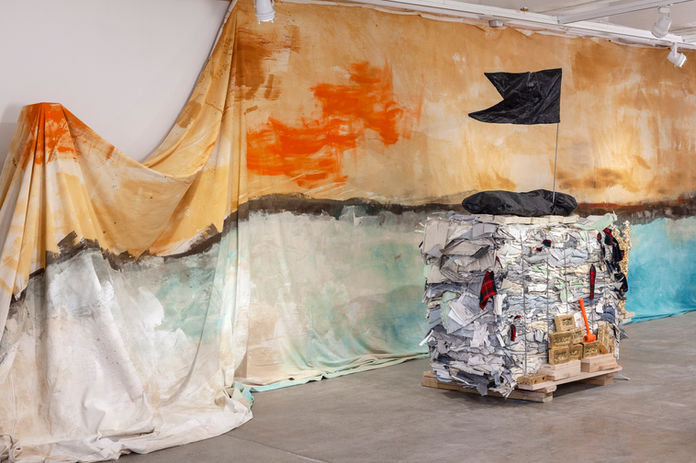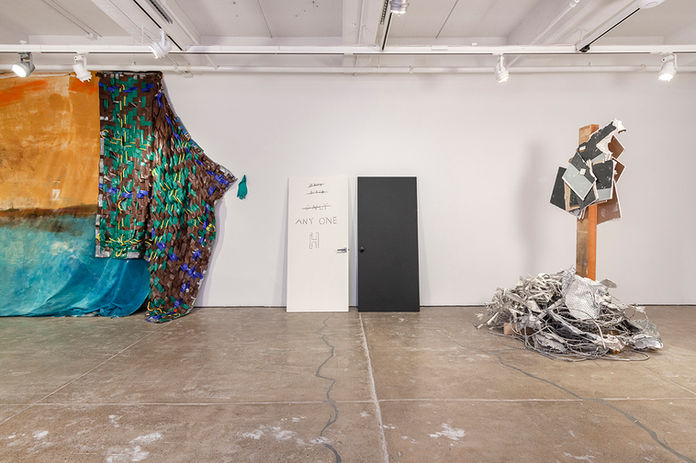
Henry Taylor
Nothing Change, Nothing Strange
Fabric Workshop and Museum, Philadelphia, Pa.
by Saul Ostrow, March 23, 2023
Henry Taylor is an African-American artist best known for his paintings of people, which are viewed as part of the contemporary cultural dialog on race and identity. His name recently came up in a discussion I was having concerning the term “unskilled-realism” a tendency that in part is a replay of late-1970s’ Bad Painting and the New Wave of the 1980s. Though both are linked to the post-Modern turn to relativism, these two practices as social and cultural phenomena are quite different. Bad Painting used as its models thrift store paintings and the work of amateur artists as a mean to question the cultural standards and criteria of Hi and Lo, while New-Wave — in the face of the collapse of Modernism — represented an engagement with the codes of mimesis and narrative. In both cases there was an indifference to traditional skills and notions of authenticity. Today, given the view that all criteria and standards are relative, both tendencies may be thought of as realist because they promoted a return to the narrative, the anecdotal, and the allegorical. I begin this review with this preface because Taylor who is 65 years old would have to know about these practices given he attended the San Francisco Institute of Art in the 1990s, where he would have also been exposed to Bay Area Funk .
Stylistically naive and charmingly unskilled, Taylor’s paintings are unlike Alice Neel whose work is deftly awkward. One might think that Taylor is actually a folk-artist who is untrained or self-taught. Folk art as a category was institutionally invented in Europe in the 19thcentury and is significantly associated with African-American culture in the States. In our post-modern-age of simulation this term, and that of outsider art, perhaps has lost its meaning given their qualities are often reproduced by “professional “artists as stylistic devices, most famously by Jean-Michel Basquiat. In Taylor’s case, we have a trained artist employing this aesthetic perhaps as a sign of authenticity and sincerity. From this perspective, Taylor can be understood to be engaged in code switching, similar to Robert Colescott who, — though he studied in Paris with Fernand Leger — turned to making crude, painterly caricatures of paintings from the art historical cannon. In his version everyone is recast as being Black.
The inspiration for Taylor’s sculptures can be found in the post-World War Two era of assemblage, junk sculpture, and outsider art. The assemblages that make up "Nothing Change, Nothing Strange" are the results of his 18-month collaboration with the Fabric Workshop and Museum in Philadelphia. The resulting works consist of makeshift arrangements of scrapped and recycled building materials and such things as bicycle wheels, tires, hand tools, chairs, and fabrics. Neither the individual pieces nor the installation as a whole were preconceived — All works were made on site and came into being in response to the discussions Taylor had with the Fabric Workshop’s studio-team members who helped him to hunt down and gather materials.
Upon first stepping into the gallery, it appears that this is a display of discreet pieces of varying size and complexity, some more abstract than others with little or no conceptual or thematic links outside of the assorted materials Taylor and his crew employed. If one isn’t going to dismiss these works as a lot of jerry-rigged stuff, one must roam around, and search for clues. With time certain motifs emerge, a central one being Scottish Tartans plaids that put in an appearance from full kilts to snippets of plaid cloth. This struck me as odd given Taylor’s work is usually discussed in terms related to racism and the social issues stemming from it.
Tartan’s consists of crisscrossing bands of color; each pattern is identified with differing Highland clans. This Scottish connection is re-enforced by a painting hung behind the gallery’s back wall —seemingly its meant to be the last thing seen or perhaps missed altogether. This painting consists of a roughly painted map of the British Isles partitioned into red, white, and blue sectors, and emblazoned with two black arrows one pointing north and the other south. Hanging over the top edge of the canvas is a toupee-like curly blond shag rug and across the bottom edge is a textured black form that looks a bit like South America lying on its side. Then enclosed in a rectangle scrawled in block letters are the words Tar/Tan and Tarzan are. This rebus is easy to decrypt —it seems to reference tarring as a form of punishment, tan is self-explanatory and the rest references the colonialism and racism portrayed in the Tarzan books and films and of course, there is always the British slave and cloth trade.
If one reaches for their iPhone and searches the web, they can also find out such interesting facts as: The Scots liked to dress their slaves in their clan tartan and that in 1790 the combined worth of exports and imports between the West Indies and Scotland totaled at least £50 million in today's currency. Yet, this painting is not quite the Rosetta stone, in that Taylor has woven still other messages and references into this installation, some less obvious than the Scottish connection. Two of the larger works in the show are tableaus. One is somewhat configured as a sailing ship which is incorporated into a number of smaller pieces referencing LA gangs, labor, and perhaps human trafficking. The other is a large loom that appears to be in the midst of being used to weave a black-on-black tartan.
Another significant feature is the two unstretched canvases each running half the length of the gallery on opposite walls. One depicts a color-field-like horizon of blue and yellow. At its center is a gold-leaf crown-form made from chain-link fencing. The other is black and green, the colors of the Black Liberation flag. At one end, this canvas appears to be unraveling but in actuality terminates in a jumble of bungy-cords, ropes, and assorted materials.
The content of the assemblages that make up "Nothing Change, Nothing Strange" alternate between the themes and iconography of the black experience, labor, trade, migration, historical events, housing, to see beyond this show’s rambling installation, material forms, abstractions, mixed codes, and theatrics requires a significant investment on the viewer’s part. Unlike Taylor’s paintings which are easily accessible, the assaying of his sculptures is a slow, demanding process, sometimes rewarding and at other times so hermetic that it seemingly is not worth making the effort.














